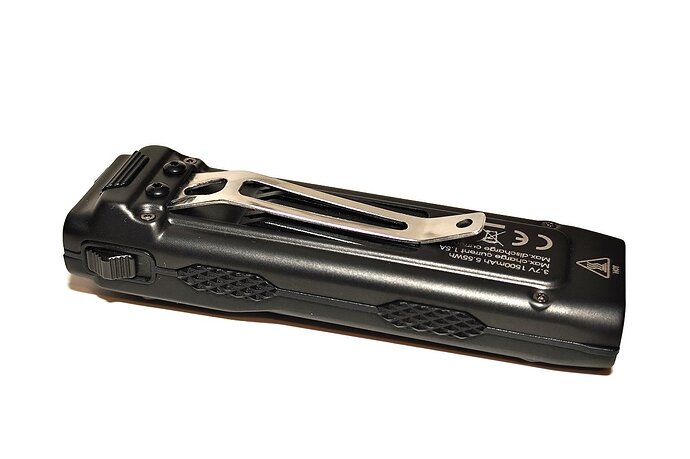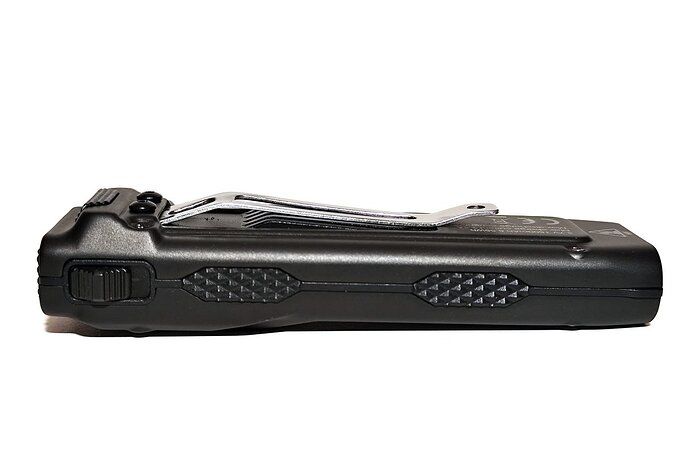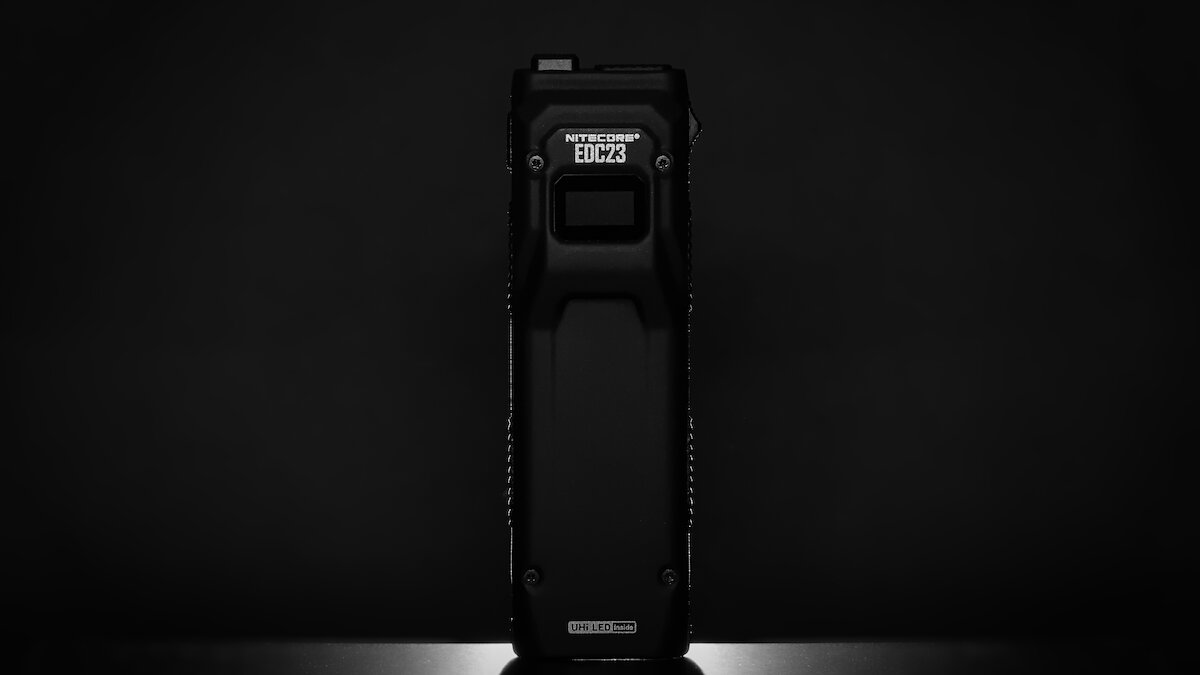
“Flat” flashlights are still very popular right now. Nitecore offers various tactical flashlights with a flat design in its EDC series. The latest model, the EDC23, focuses on the EDC properties.
Earlier models were simply too long for the pockets of regular pants. The EDC23 is quite a bit shorter, but still has the same tactical features as the larger models.
You can find the German version of this review on my website: SammysHP Blog › Nitecore EDC23
The flashlight was provided by the manufacturer for this review. Thank you very much!
Overview of hardware
Due to the monolithic design, there are only a few accessories in the box:
- Paracord lanyard
- USB-C charging cable
- Manual (EN, DE, FR, RU, JP, KO, IT, UA, CN)
The battery is integrated, the clip already attached and there is no need for replacement seals as everything is screwed together. The instructions are comprehensive and easy to understand.
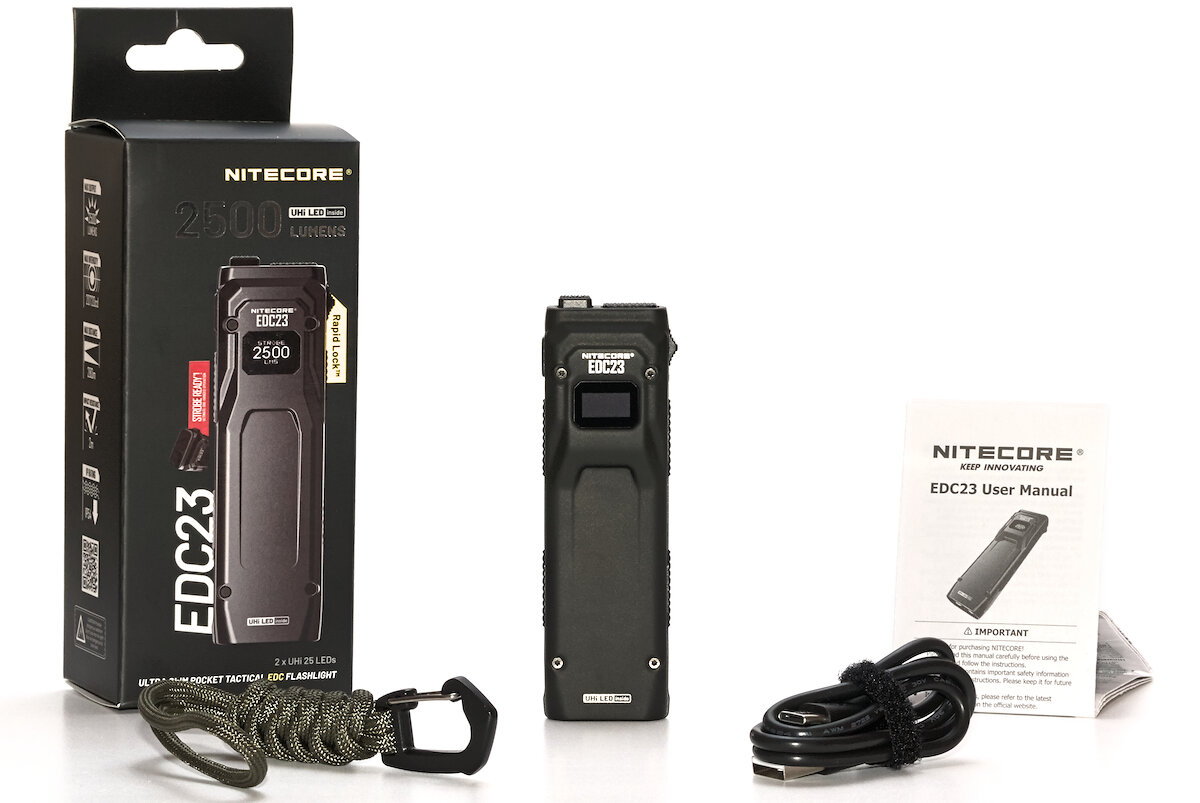
One advantage of “flat” flashlights is that they are not as bulky in the pockets of your pants as round models. However, if the flashlight is too long, it still won’t fit all the way, for example when sitting down. On the other hand, if it is too short, I’d rather call it a keychain flashlight. So you need to find the right compromise.
As the flashlight does not have a uniform shape, I have measured the narrowest and widest points (measured without the clip):
| . | Minimum | Maximum |
|---|---|---|
| Length: | 100.8 mm | 102.8 mm |
| Width: | 30.3 mm | 33.0 mm |
| Thickness: | 13.7 mm | 20.7 mm |
| Weight: | 95.3 g |
In fact, flat flashlights are still clearly underrepresented in my collection. So here is just a direct comparison with the JETBeam E26 and the Wurkkos HD01 UV.
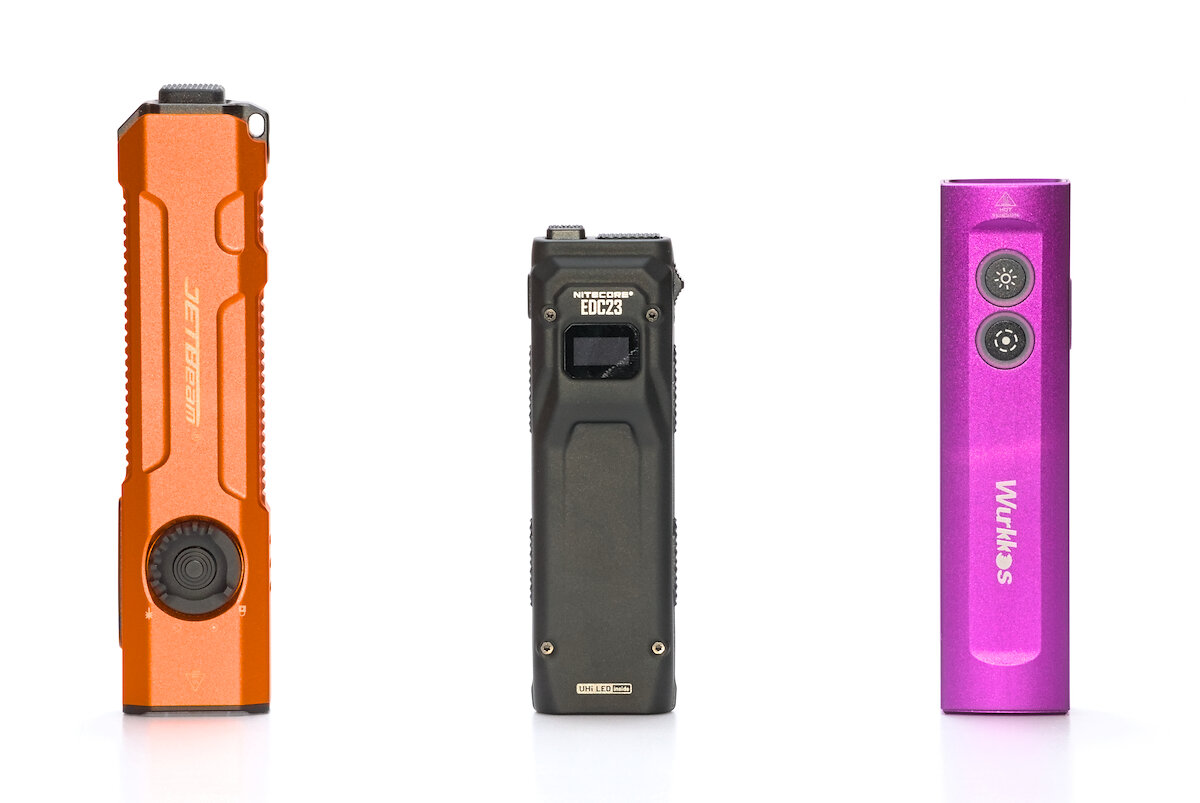
JETBeam E26 | Nitecore EDC23 | Wurkkos HD01 UV
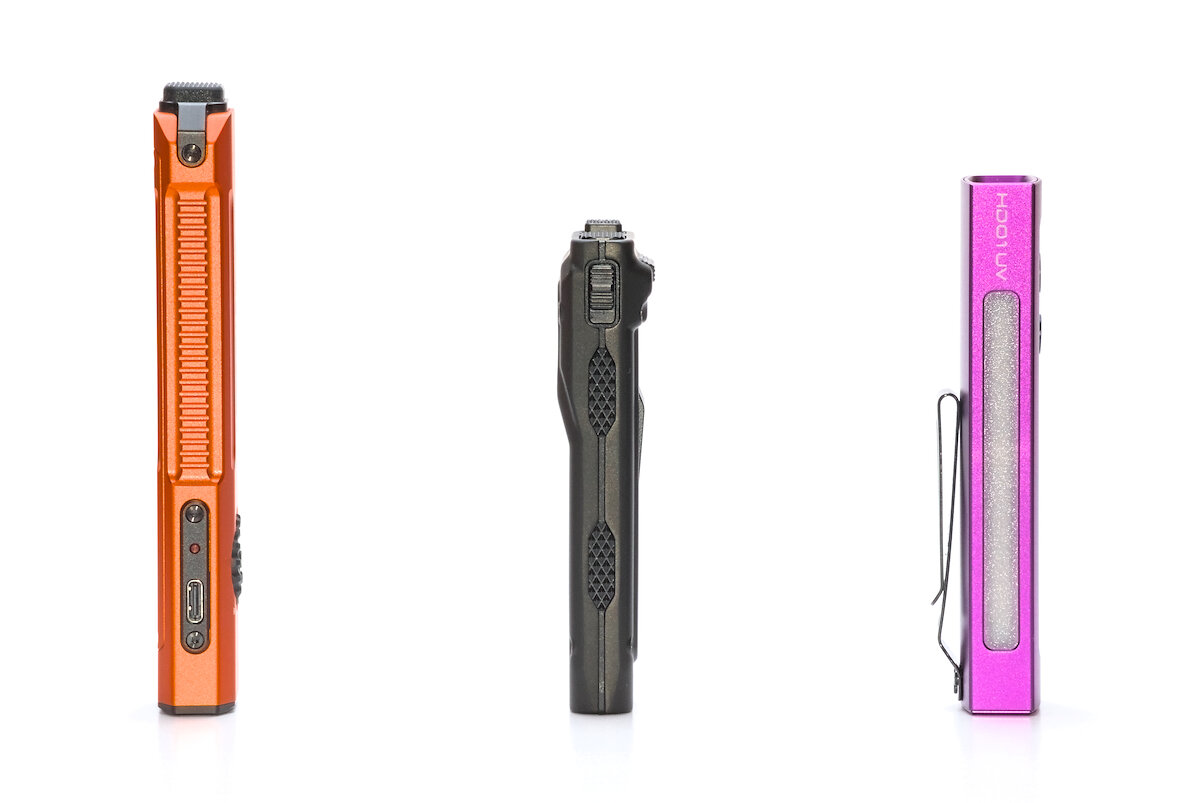
The front area around the LEDs is the flattest part of the flashlight. To improve the grip of the flashlight, there are two zones with diamond-shaped knurling on each side.
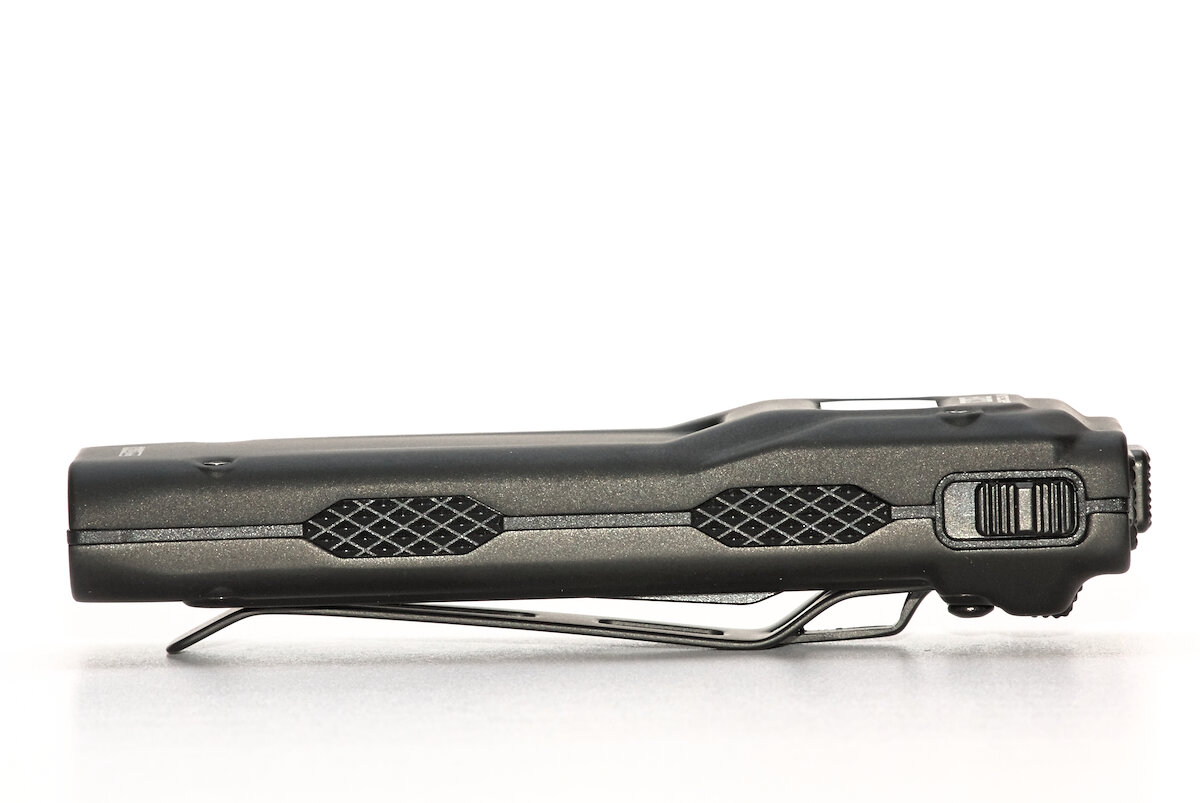
In addition to the buttons, there is also an OLED display at the rear end to show the status, which is why the flashlight is slightly thicker in that area.
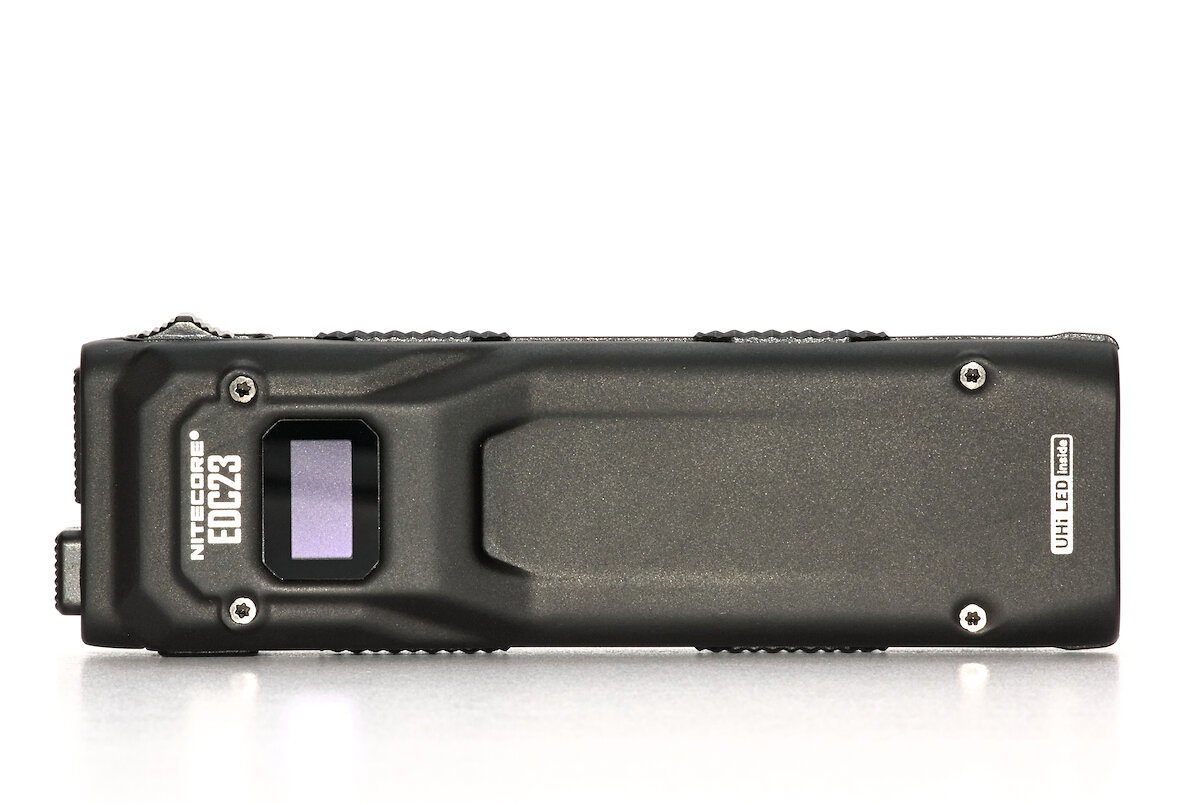
The EDC23 has multiple layers: The electronics are located in a plastic frame, which is surrounded by molded metal shells. To improve the cooling of the LEDs, the heat is transferred with something like a heat pipe to the backside of the flashlight, where it is dissipated via a large heat sink. It is covered by the clip so that it is not normally touched directly.
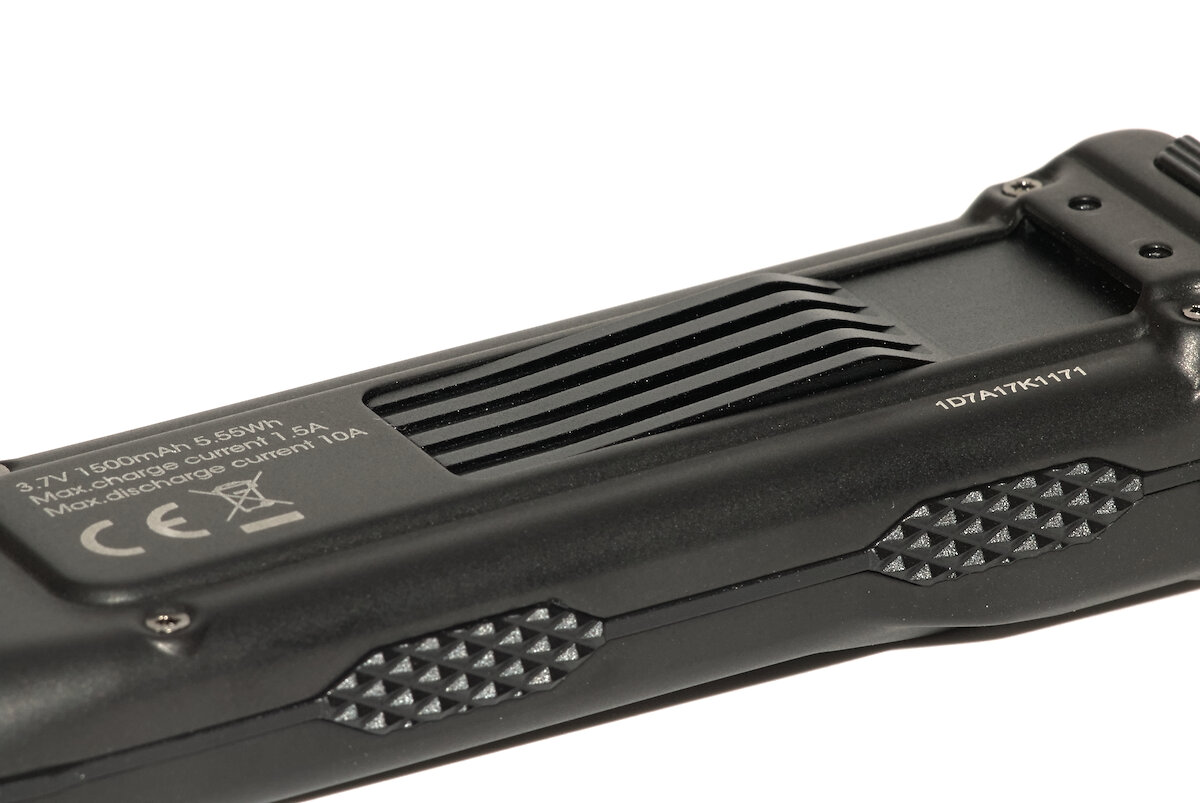
The clip extends over almost the entire length of the flashlight and appears somewhat oversized. It is possible that Nitecore wanted to continue using the clip from the other EDC models. It is pushed into a small slot of the case and secured with two T6 screws.
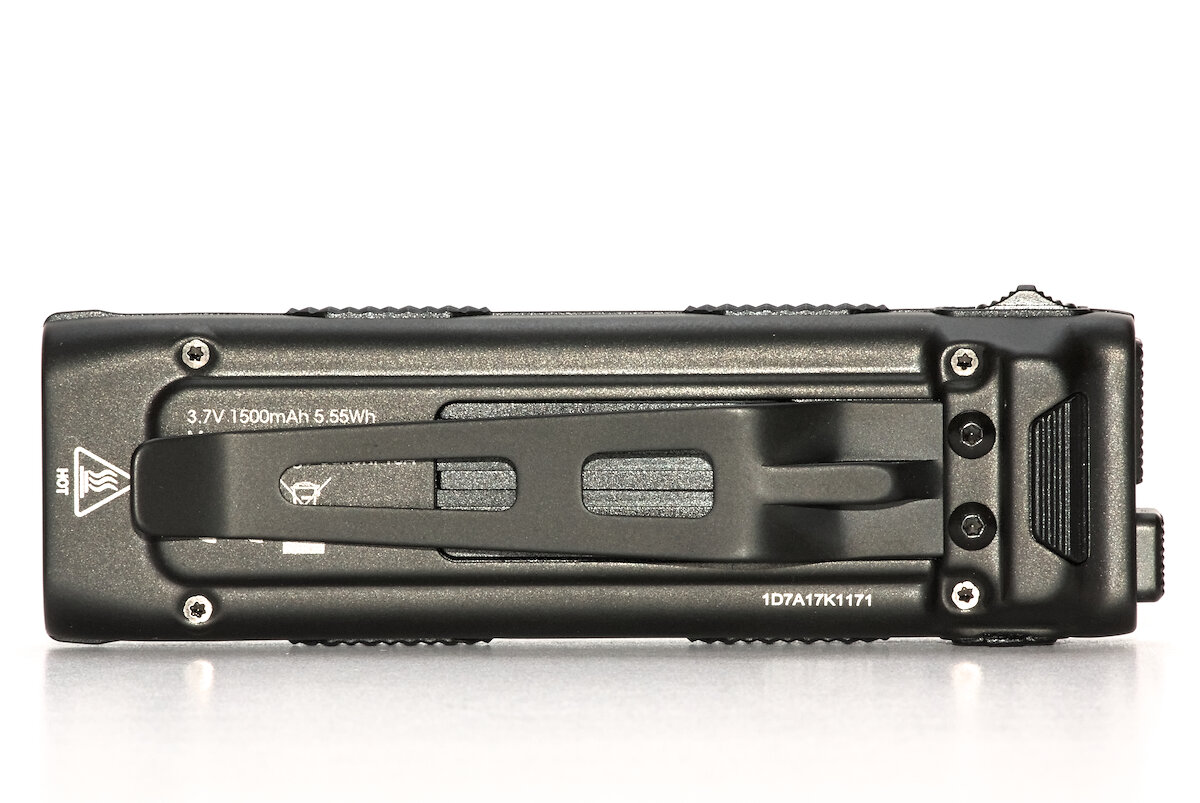
The opening of the clip sticks out quite a bit to make insertion easier. On the other hand, the tip feels slightly annoying. A Z-shape might have been the better choice for it. There is an eyelet at the rear end of the clip for attaching a lanyard. However, if the clip is removed, the lanyard can no longer be attached. (Exception: You could thread a thin cord through the holes of the screws.)
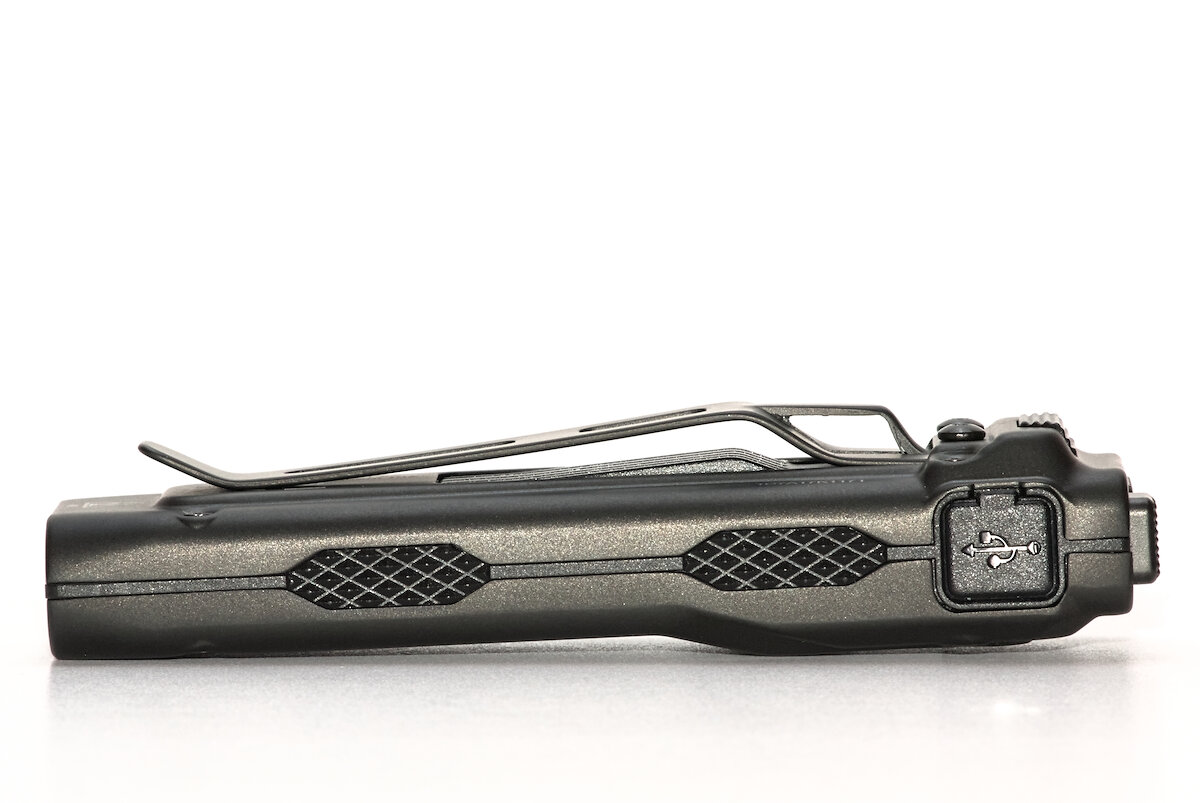
The most serious disadvantage of this design is that the flashlight protrudes far out of the pocket. A flashlight of this size simply needs a clip that allows deep carry.
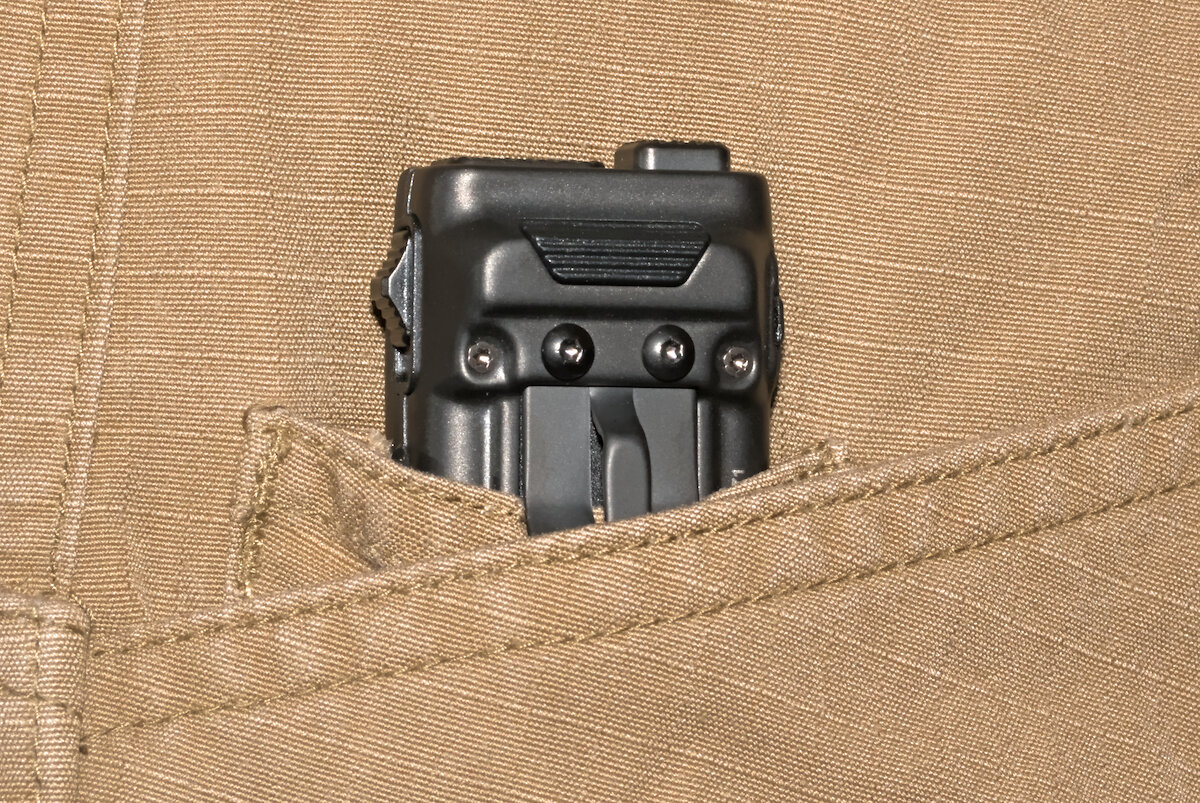
The flashlight is charged via USB-C. A cover provides a certain degree of protection against dirt and water. The overall waterproofing of the EDC23 makes it kind of unnecessary, though.
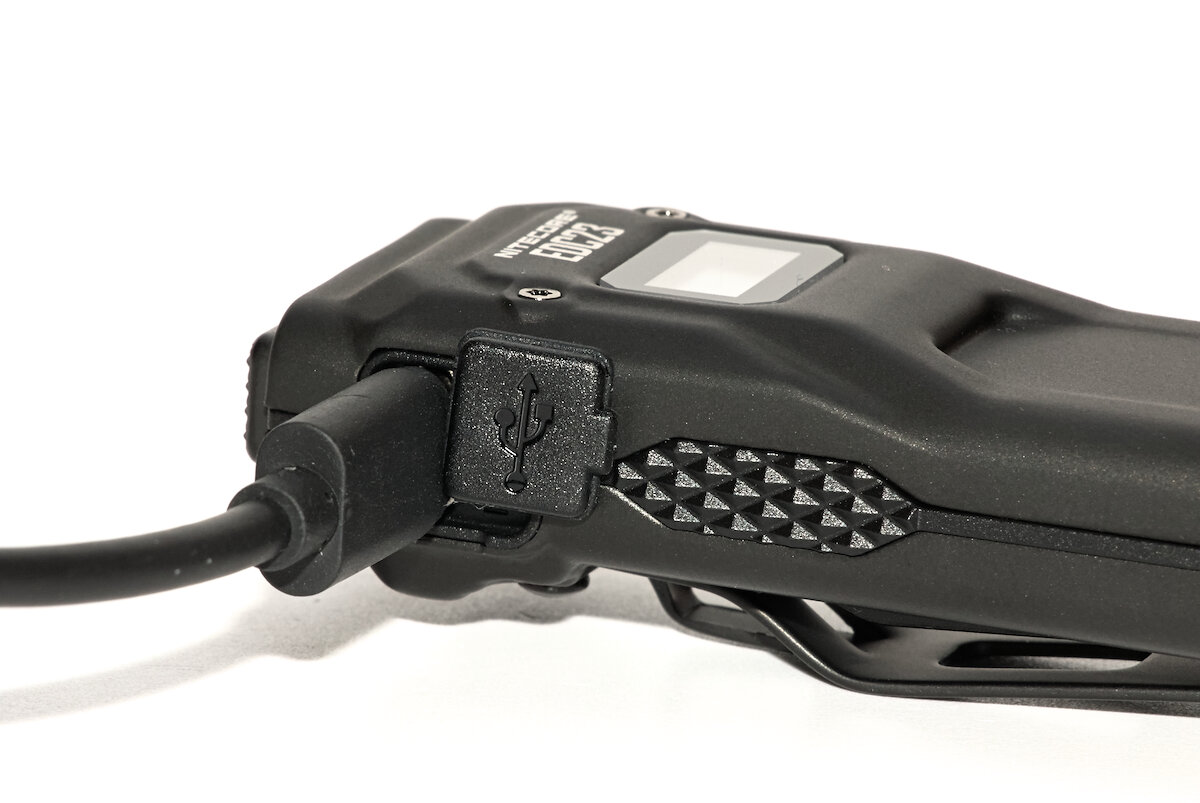
The charging progress can be seen on the OLED display. Instead of a percentage display, the battery voltage is shown. The display is active both during charging and afterwards until the USB cable is disconnected.
At 1.5 A, the charging process is pleasantly fast and is completed after just under 1.5 hours. However, the flashlight heats up to 45°C in the process. As the battery cannot be swapped and you may want to recharge the flashlight with a powerbank, a more efficient charge controller would have been nice. During charging, the flashlight can be used normally - with the exception of Turbo and Strobe.
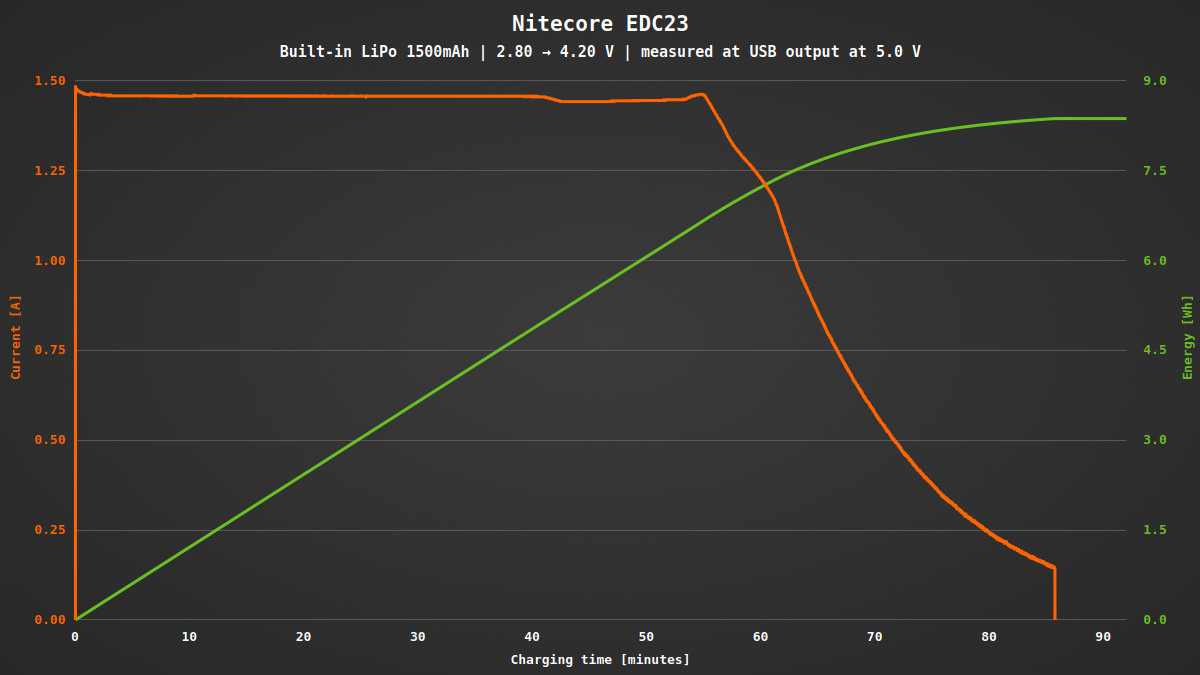
The build quality is very good in most aspects. The buttons have a little more play than I expected, the plastic lugs at the front end made me think of a production error (but they also have this shape in official product pictures).
However, I am concerned about the specified protection of only IP54. The last number indicates the protection against water and in this case means “protection against splashing water”. A few raindrops are certainly no problem for the EDC23, but if the flashlight lands in a puddle, it could be damaged. An EDC flashlight - and especially a tactical one - should be able to withstand a little more. Tim McMahon recently disassembled the very similar EDC29 and documented the process in a video:
There are apparently no proper seals. This means that water can penetrate, particularly in the area of the buttons, but it also finds a way under the metal shells. Covering the USB port is therefore unlikely to have much effect. A nice alternative would have been an internally sealed USB port without a cover, as found in many smartphones, for example.
At some point, the performance of the battery will start to drop. As it is permanently integrated and cannot be replaced, this also means the end for the flashlight. However, this is a problem that affects most flashlights of this design.
User interface
From a “tactical” flashlight I expect a well thought-out user interface that allows for reliable operation even in stressful situations. Quick access to turbo and maybe strobe as well as a predictable brightness when turning it on (either always start at the same brightness or reliable memory) are useful.
The EDC23 achieves this by using multiple buttons: a slightly protruding power button, a flat mode button and a sliding lock switch. Both buttons have two electronic stages of actuation.
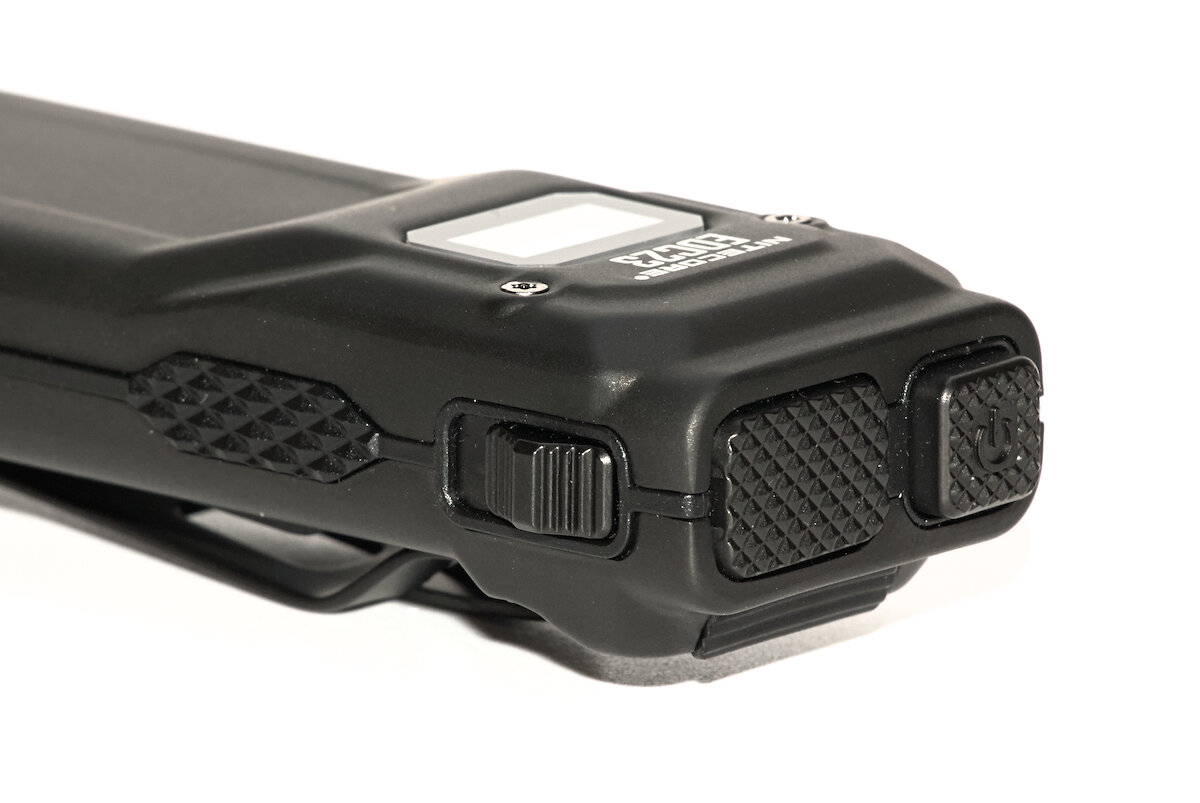
The flashlight is switched on and off by fully pressing the Power button to the second stage (1050g actuation force). By briefly tapping it to the first stage (220g), the brightness can be gradually increased in four steps when the flashlight is switched on: Ultralow, Low, Medium and High.
If the button is tapped when the flashlight is switched off, the brightness can be pre-selected in advance (the level is shown on the display). Holding the power button in the first stage temporarily activates Ultralow mode, both when the flashlight is switched off and when it is on (for example, to check a document and briefly reduce the brightness to avoid being blinded).
The Mode button provides direct momentary access to turbo and strobe. Turbo is activated by holding the mode button in the first stage (450g). During use, a progress bar on the display shows the remaining runtime - and it moves fast! When the flashlight is cold, a maximum of eight seconds at a time is possible and the flashlight switches down to a lower level. If you release the button, the progress bar slowly fills up depending on the temperature. This means that Turbo can only be used for a short time when the flashlight is already warm. As I only ever use Turbo for short periods, the short runtime has never bothered me. It really is just a turbo and not a permanent level (you need a larger flashlight for this).
If you press the mode button all the way down to the second stage (950g), you activate strobe. Not only does the frequency change regularly, but also the duty cycle is adjusted. This makes the strobe particularly disorientating.
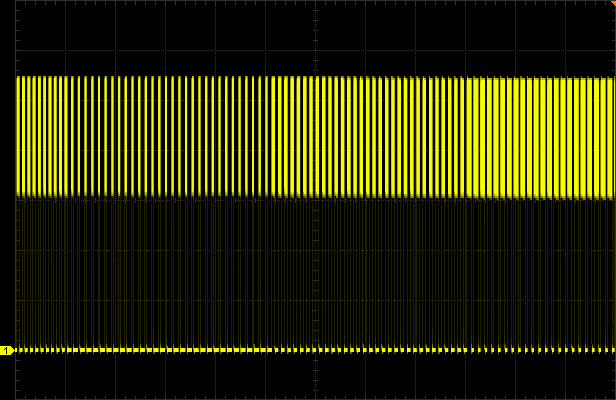
That leaves the lockout, called “Rapid Lock”: A slide switch at the side locks all buttons when in the upper position. This is referred to as “Full Lockout (Lockout 2)”.
If you hold down the Mode button while activating the lockout, you enter the “Semi Lockout (Lockout 1)”, in which only the Power button is locked. The mode button is then still available for turbo and strobe.
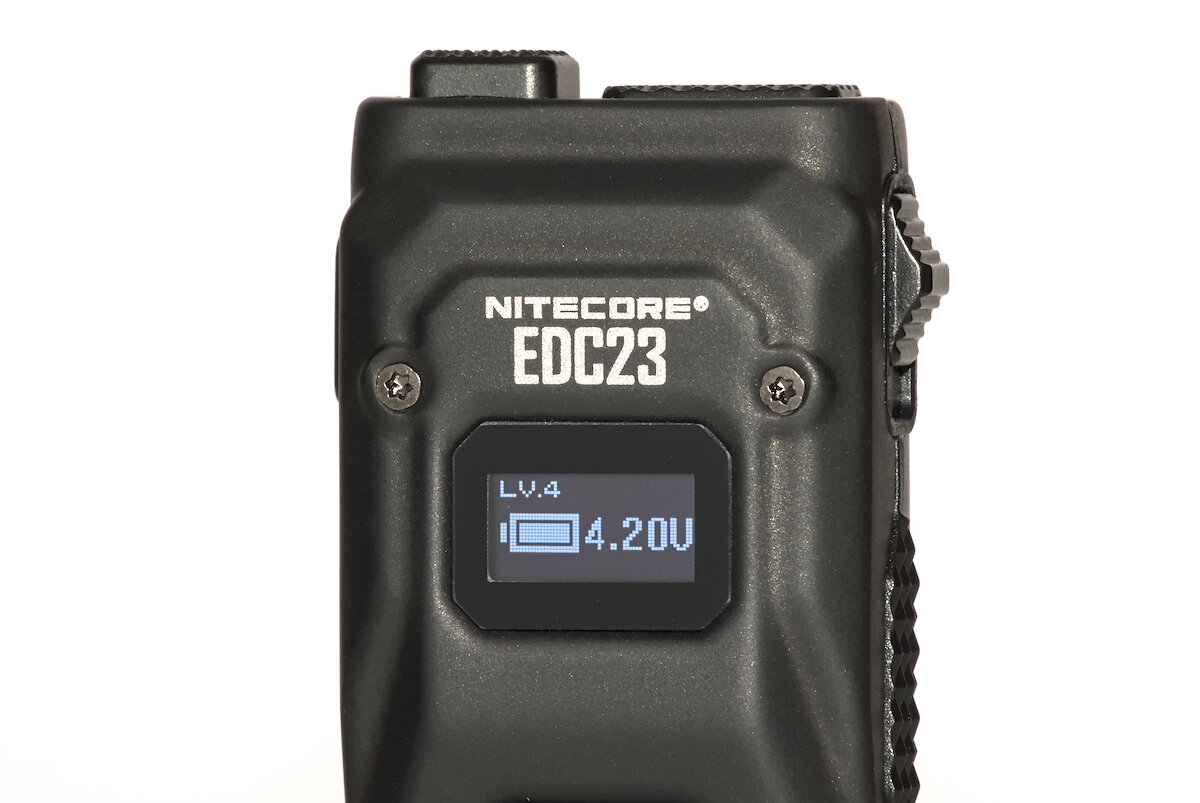
When the flashlight is switched on and each time the button is pressed, the current status is shown on the OLED display for 10 seconds. The current level and the remaining runtime at this level appear one after the other. When the flashlight is switched off and the power button is pressed, the selected level and the battery voltage are displayed for two seconds.
This display is somewhat gimmicky. A few LEDs like on the EDC25 would probably have been sufficient. On the other hand, it doesn’t really bother me and the display of the remaining runtime is extremely practical in particular.
A special feature is hidden between the two LEDs at the front: a brightness sensor that reduces the brightness when an object is detected in front of the emitters. This is intended to reduce the risk of fire if the light is switched on unintentionally. However, the sensor is only active in the High level and only directly when the light is switched on. After triggering, it can be temporarily deactivated by briefly tapping the power button. In practice, I have never noticed any negative effects of this function.
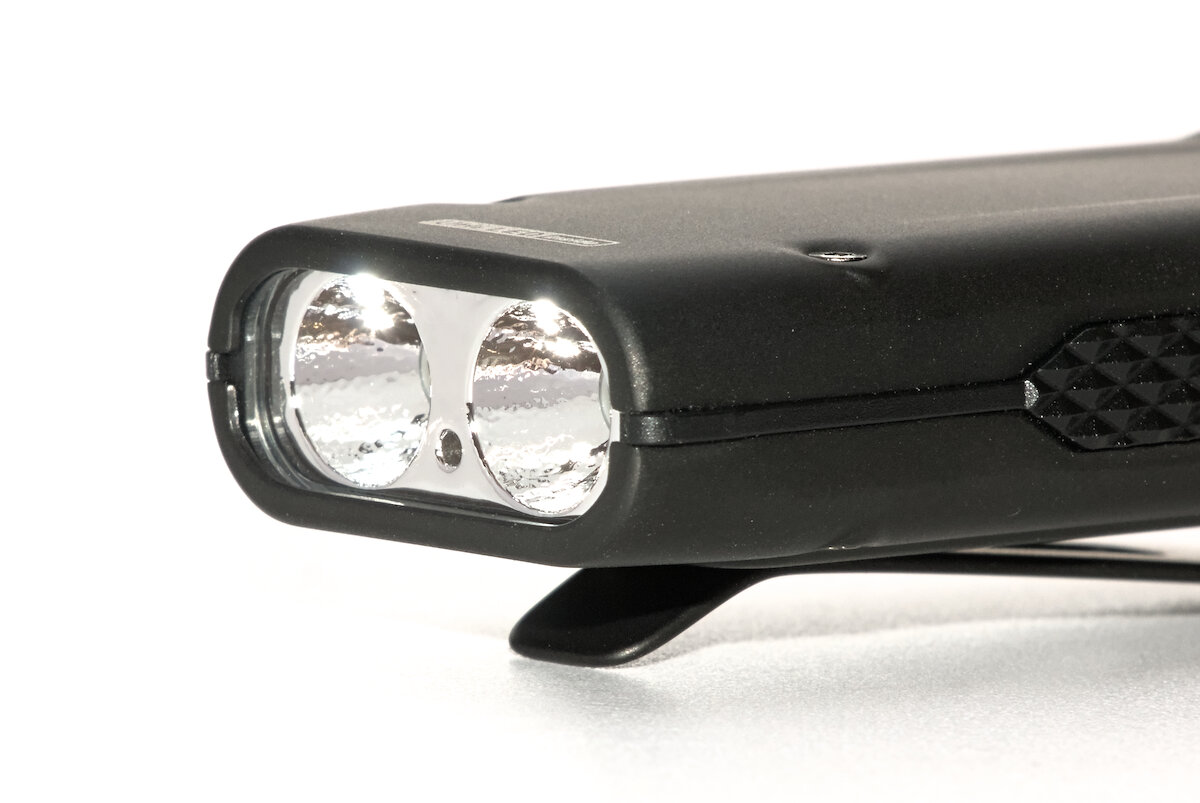
I was impressed with the handling of the EDC23. It sits comfortably in the hand and can be operated completely with the thumb without having to reach around. It might be a little too small for users with large hands, but it is the perfect size for my hands.
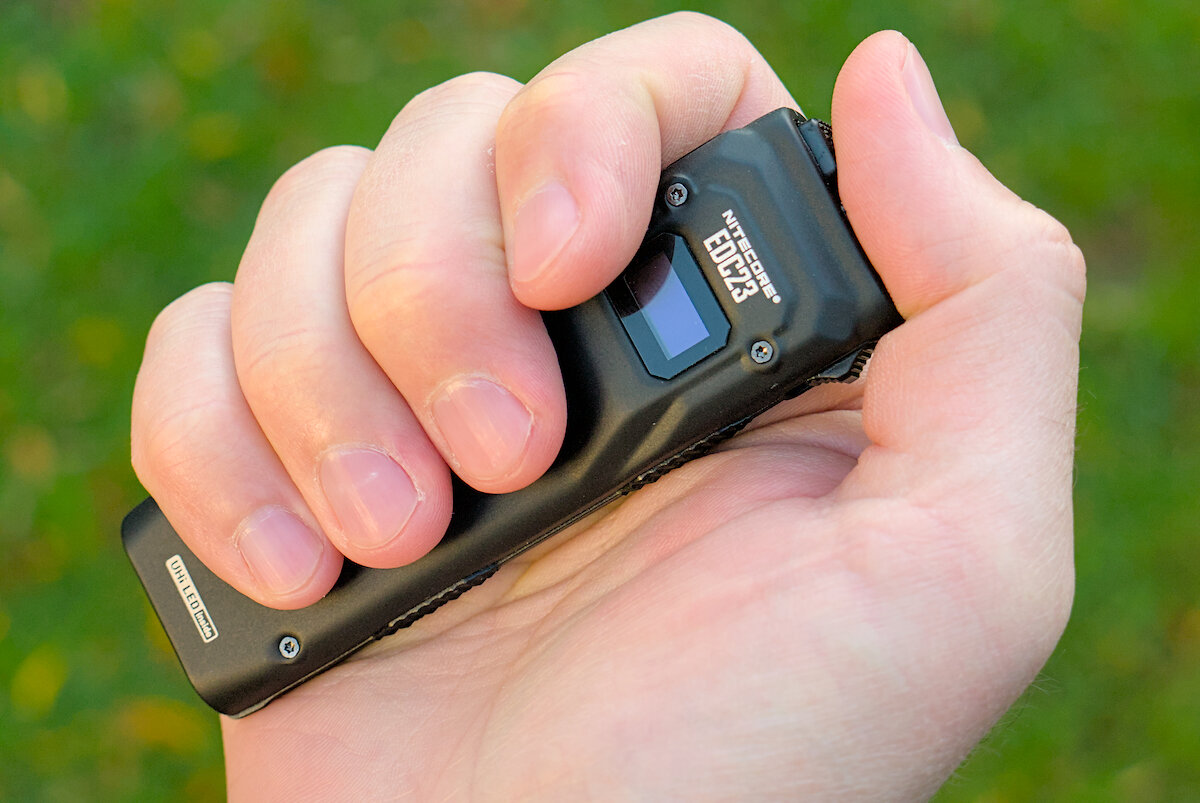
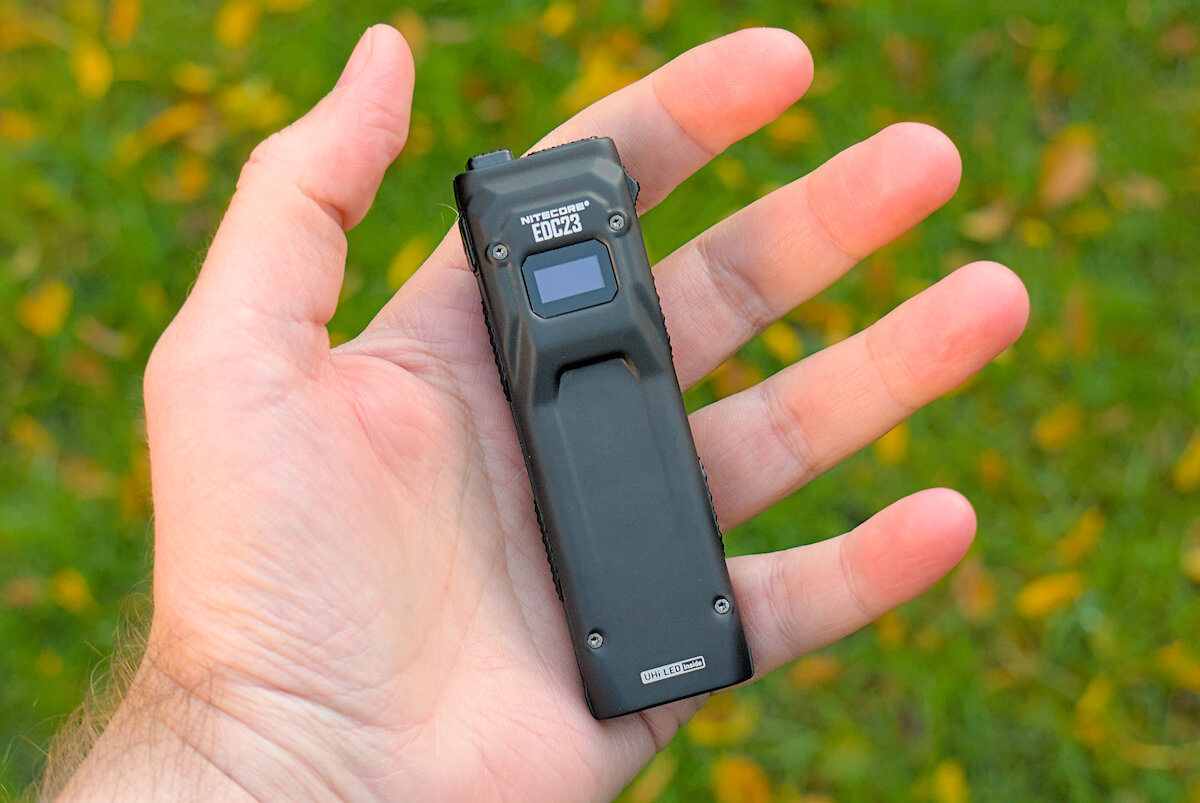
Illumination
First things first: The light produced by the EDC23 is not “beautiful” with a warm white color temperature, neutral tint and high CRI. But I don’t expect that from a tactical flashlight, where the focus is on efficacy and maximum performance.
Two “NiteLab UHi 25” LEDs are used in the EDC23. This is how they are marketed by Nitecore, but they look very similar to the Luminus SFT-25R. Maybe they are specifically produced for Nitecore with custom properties, or maybe they are simply identical. Either way, it is an interesting LED, as it is perfectly suited for small throwers with its rather small and round light emitting surface.
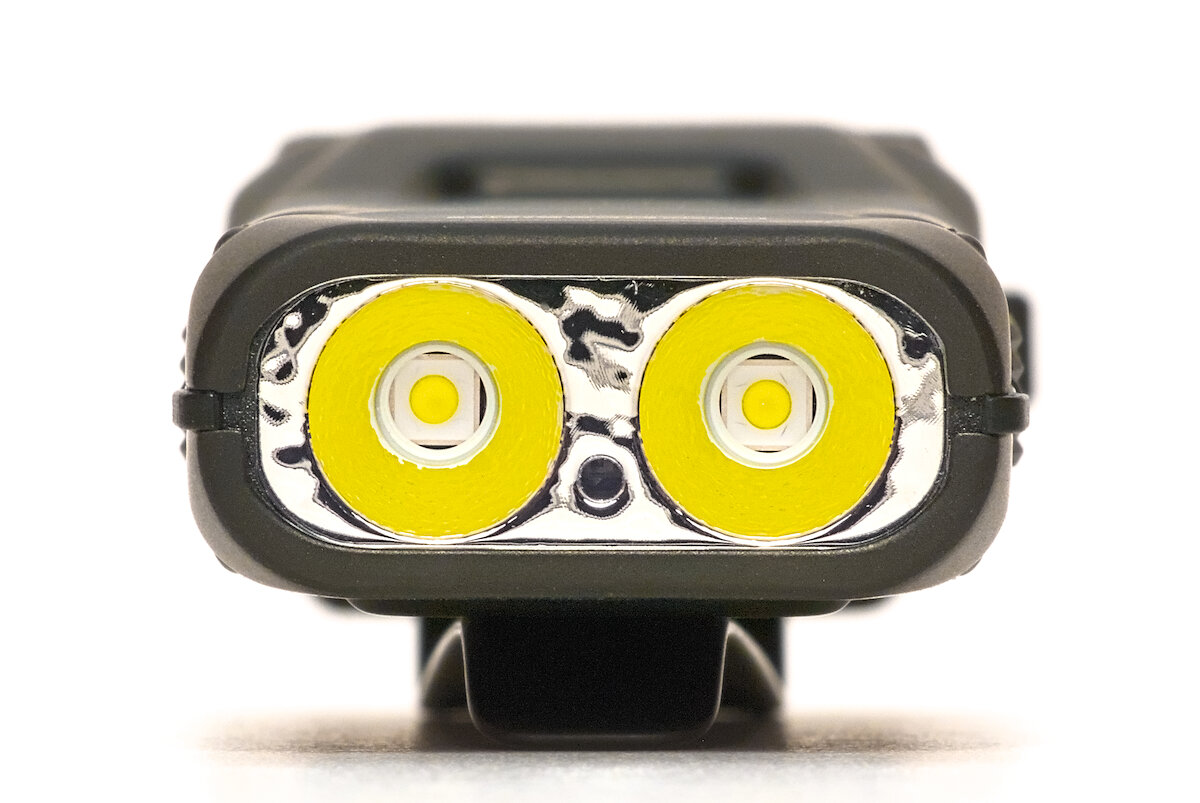
And the LEDs work very well in the EDC23. The two small, textured (orange peel) reflectors produce a powerful spot with a soft corona and a pleasingly long throw for such a small flashlight. The glass in front of the emitters has a magenta-colored anti-reflective coating.
The color temperature is estimated at just under 6000K. Unfortunately there is a slightly green tint, but this was to be expected from efficient LEDs. You shouldn’t have too high expectations when it comes to CRI either.
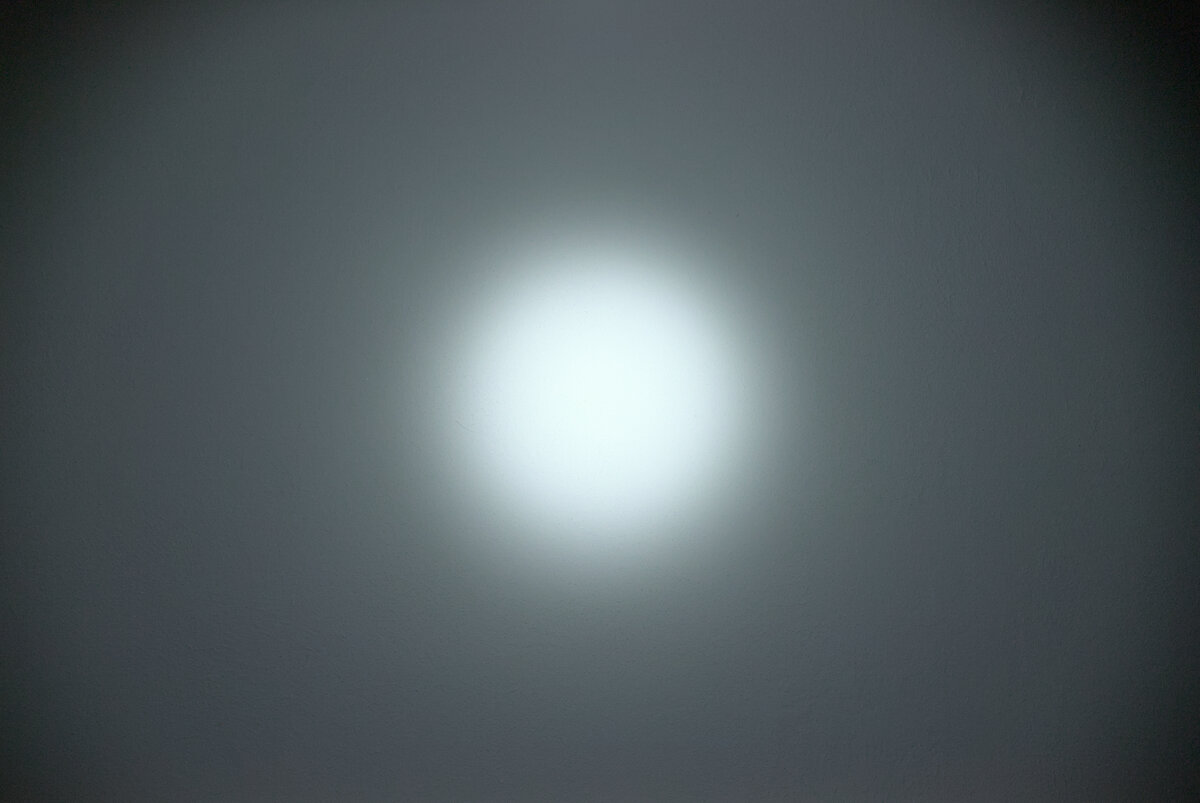
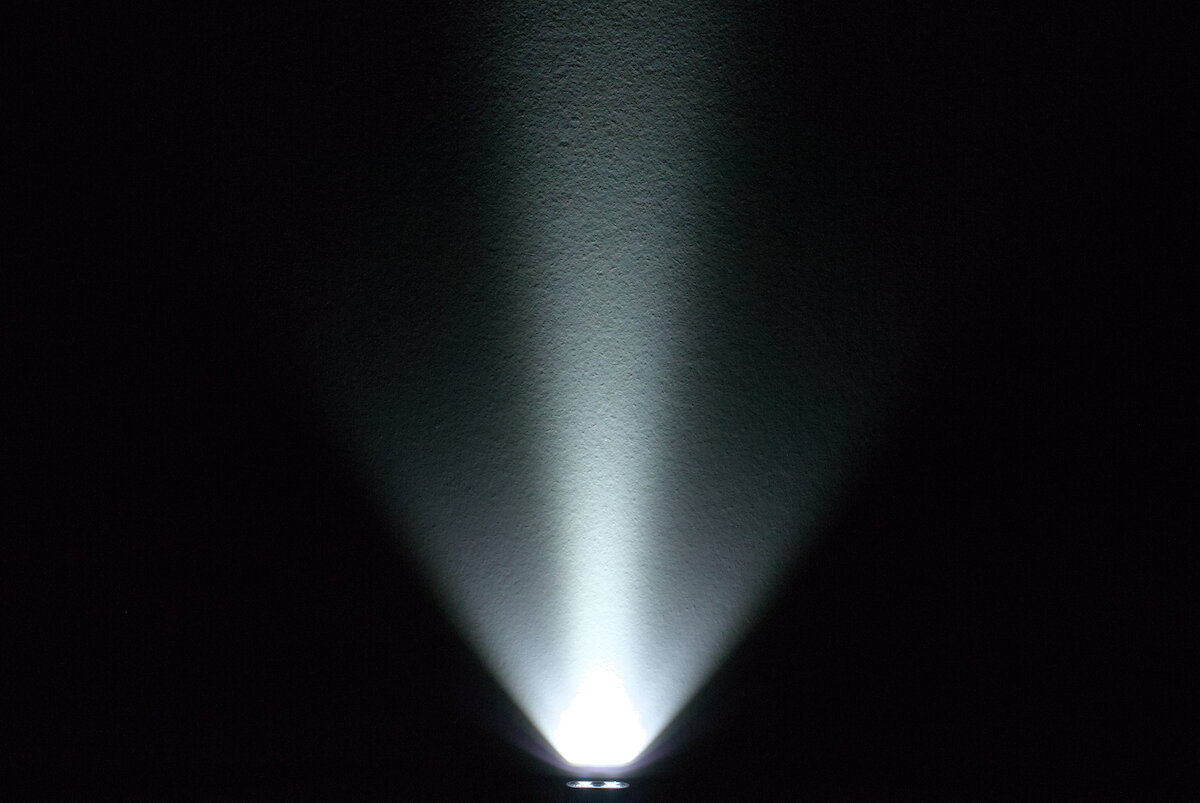
Due to the flat design of the flashlight, there is a slight shadow visible in the spill at the top and bottom caused by the bezel. However, I do not find this to be a problem in practice.
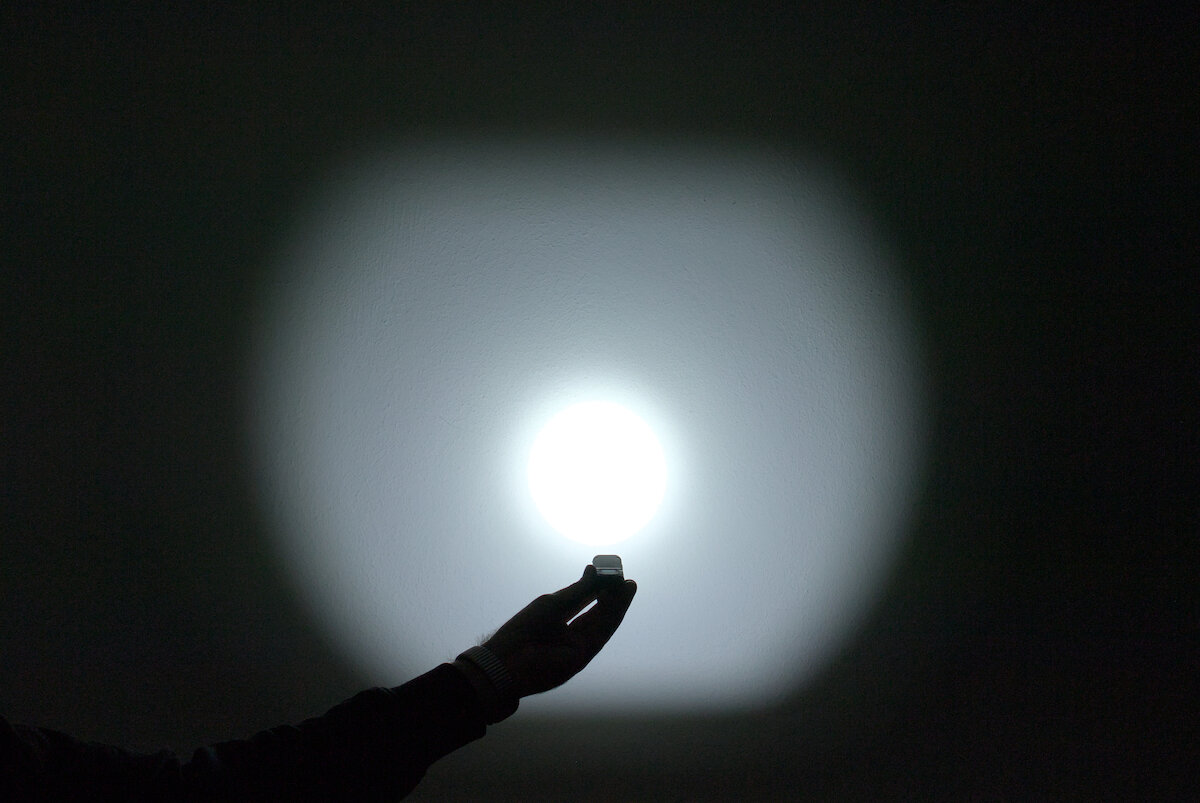
The soft corona around the spot makes the light suitable for both medium and long distances up to around 80 m. For a longer runtime, it is beneficial to reduce the brightness and rely on the intensity of the spot. Even the lowest brightness is sufficient for a few meters. At close range, for example when reading documents, you might have to move the spot around a bit.
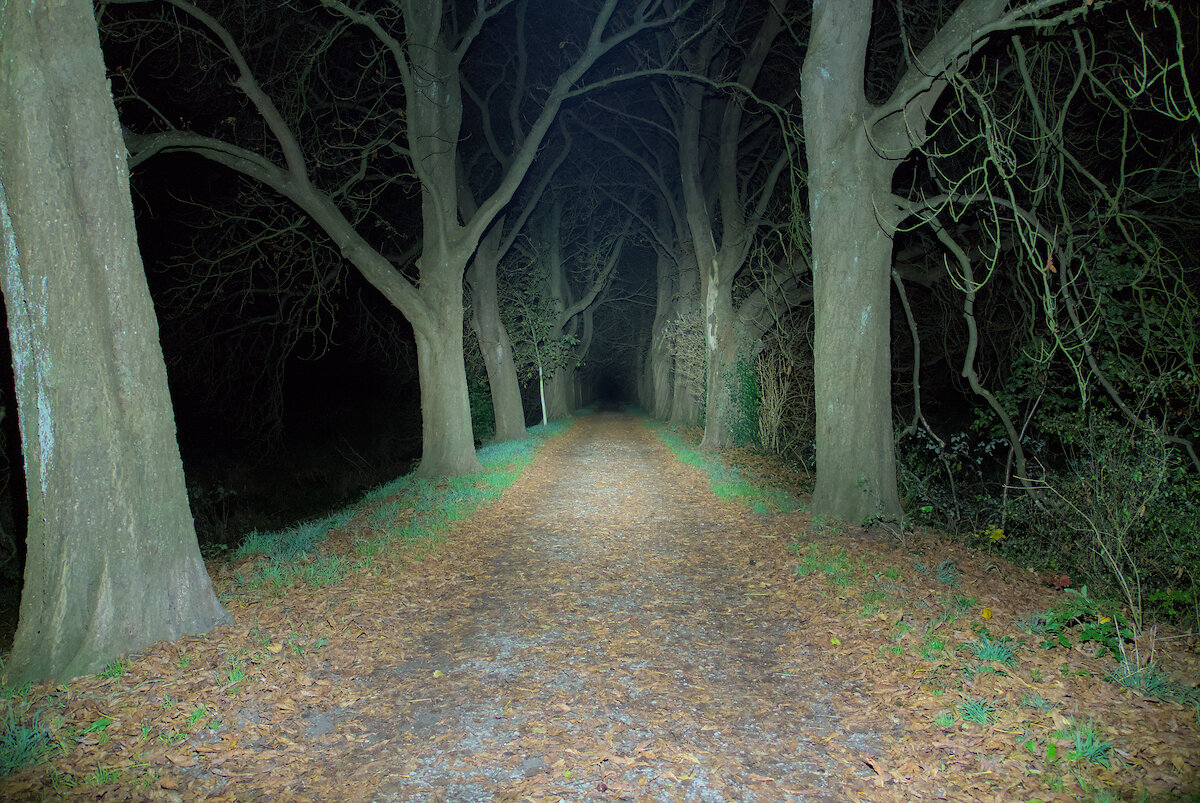
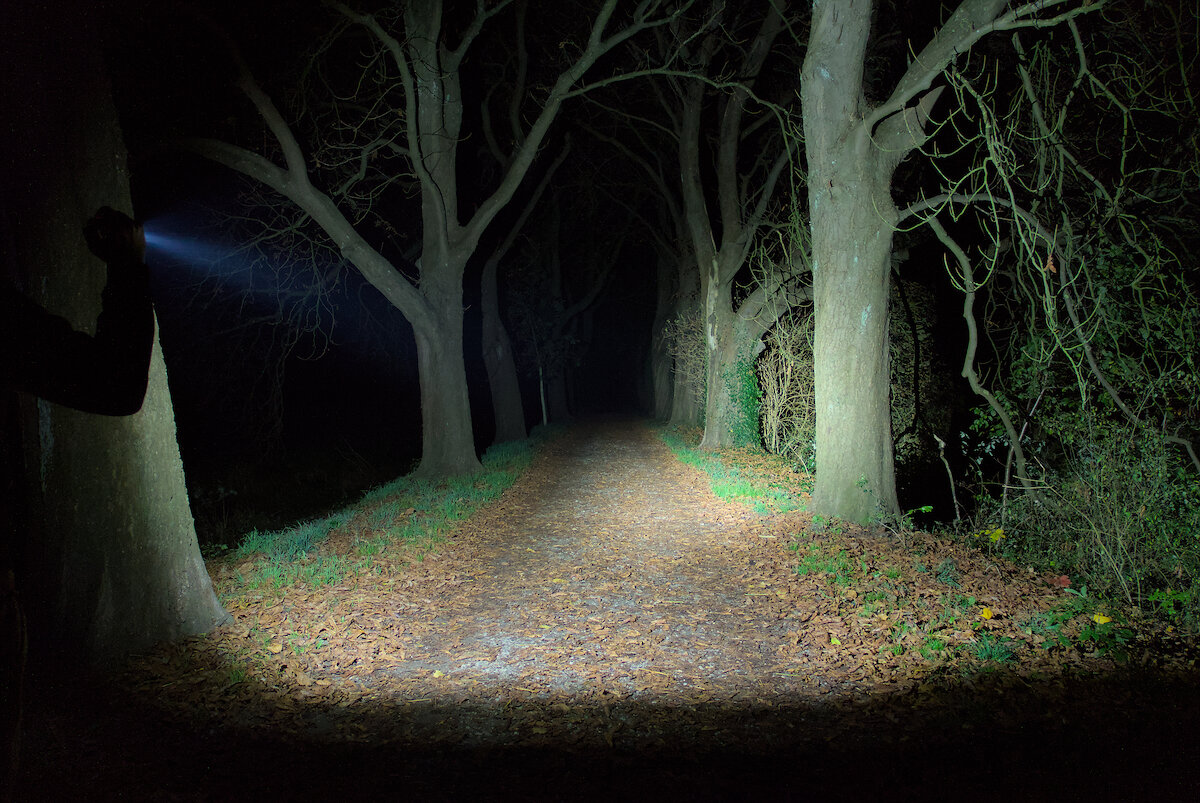
Driver and runtime
The combination of efficient LEDs and an efficient driver allows for pleasantly long runtimes. I usually use the Low or Medium with a runtime of 11 or 3:45 hours, so that the flashlight rarely needs to be charged. The remaining runtime shown on the display is very helpful to decide whether the battery charge is still sufficient for use.
| Mode | Brightness¹ | Runtime¹ | Intensity¹ (Throw²) |
|---|---|---|---|
| Turbo | 2500 lm | ––– | 20 720 cd (280 m) |
| High | 1100 lm | 1:30 h | 8 800 cd (185 m) |
| Medium | 200 lm | 3:45 h | 2 000 cd (90 m) |
| Low | 65 lm | 11 h | 680 cd (50 m) |
| Ultralow | 15 lm | 39 h | 145 cd (24 m) |
¹ According to manufacturer ² ANSI FL1
At the brightest regular level “High”, the brightness initially increases as the flashlight heats up. I guess that the properties of some components change depending on the temperature. After about three minutes, the flashlight reaches a temperature of 50°C and the brightness is reduced. All other levels run at constant brightness until shortly before the end. This is followed by a quick step-down to the lower levels, followed by a longer period at the lowest brightness before the flashlight turns off.
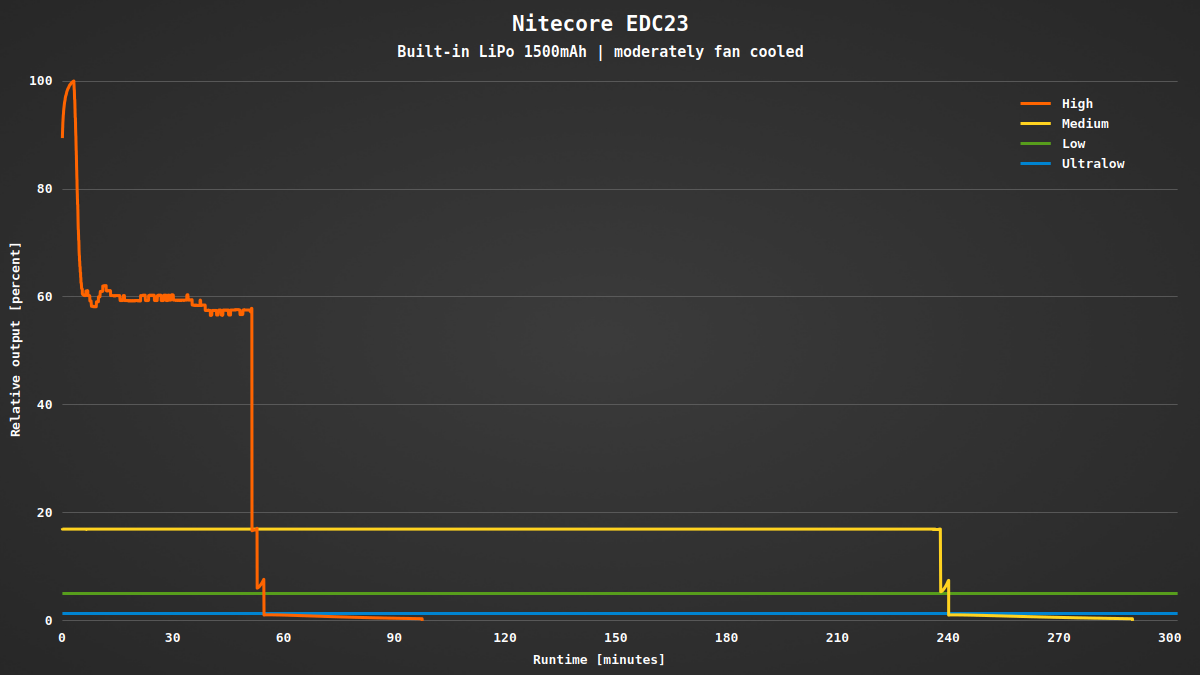
The EDC23 has active temperature control and adjusts the brightness so that the temperature is kept as constant as possible. I can’t explain why the regulation is sometimes done in small steps, but smooth in other cases.
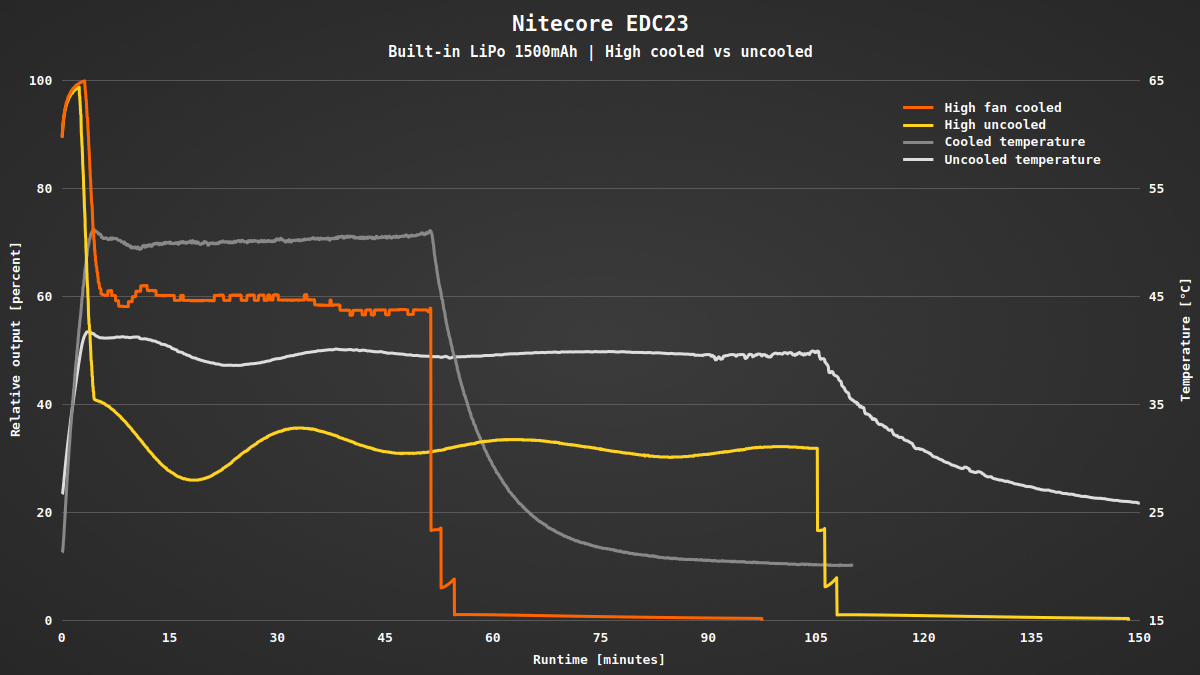
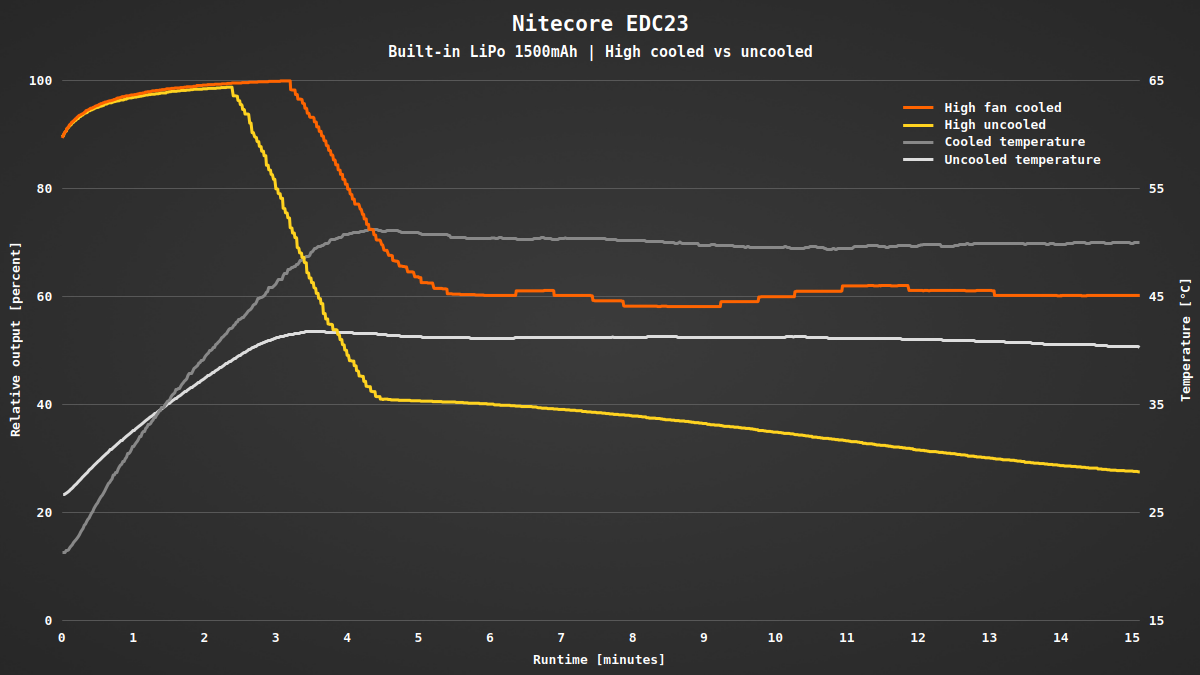
I have excluded Turbo from my regular runtime tests, as it is only active when the button is held down and is only available for a short time. A maximum of eight seconds at a time is possible, but this time might be reduced to two seconds if the flashlight is already hot. Due to the high temperature, it then immediately steps down to a significantly lower level. In the following test, I used the flashlight at its limits:
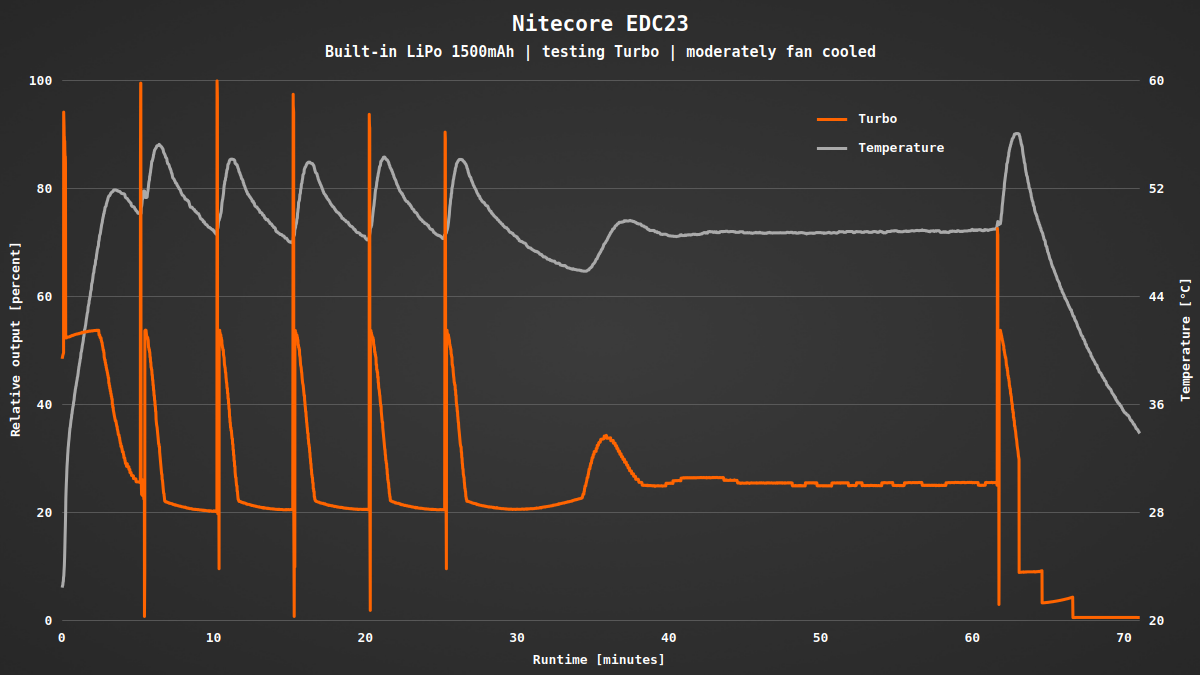
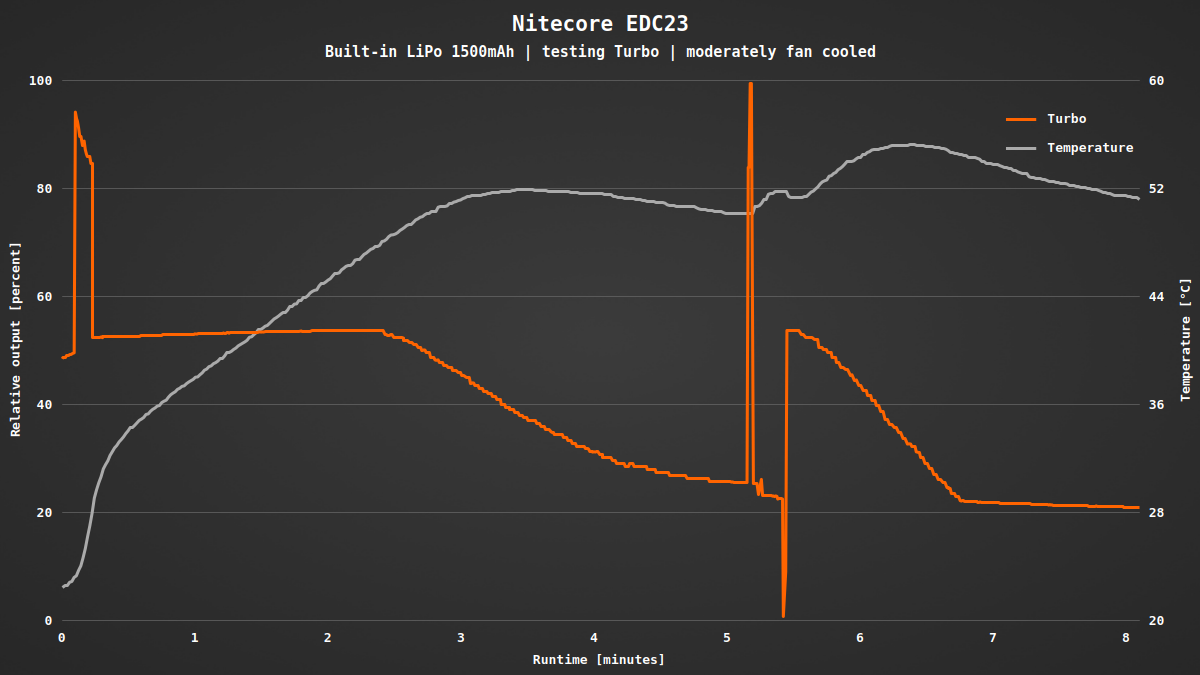
I was unable to measure the power consumption due to the inaccessible, built-in battery. However, the battery voltage is shown on the display, so I was able to determine that the flashlight switches off when the voltage drops below around 2.8 V to prevent the battery from discharging too deeply.

All levels are controlled via the constant current driver without PWM. Only in turbo I was able to measure short dips with the oscilloscope at a fast frequency of 19 kHz. These cannot be seen by eye.
Conclusion
The Nitecore EDC23 EDC flashlight has been my everyday companion for a few weeks now. Thanks to its flat design and compact dimensions, it disappears nicely into the pockets of my pants. Nevertheless, it offers unexpectedly high performance for its size and a long runtime. I particularly like the operation with a separate button for turbo and a slide switch for the lockout.
The beam was optimized for high efficacy and throw. Therefore you have to accept some compromises, particularly with the light color: a slightly green tint and low CRI are the result. It would be nice to have a clip that allows the flashlight to be carried deeper in the pocket.
Got curious? Here you can find the Nitecore EDC23 in the official Nitecore US store.

